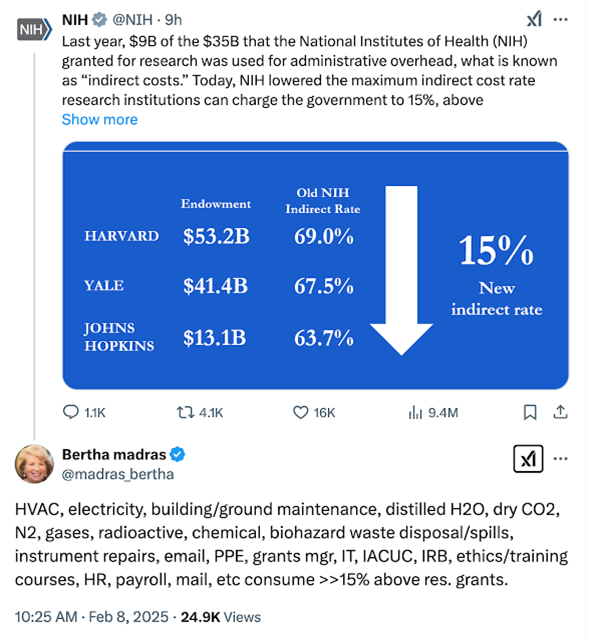Indirect cost recovery (ICR) seems like a boring, technical budget subject. In reality, it is a major source of the long-running budget crises at public research universities. Misinformation about ICR has also confused everyone about the university’s public benefits.
These paired problems—concealed budget shortfalls and misinformation—didn’t cause the ICR cuts being implemented by the NIH acting director, one Matthew J. Memoli, M.D. But they are the basis of Memoli’s rationale.
Trump’s people will sustain these cuts unless academics can create an honest counternarrative that inspires wider opposition. I’ll sketch a counternarrative below.
The sudden policy change is that the NIH is to cap indirect cost recovery at 15 percent of the direct costs of a grant, regardless of the existing negotiated rate. Multiple lawsuits have been filed challenging the legality of the change, and courts have temporarily blocked it from going into effect.
Memoli’s notice of the cap, issued Friday, has a narrative that is wrong but internally coherent and plausible.
It starts with three claims about the $9 billion of the overall $35 billion research funding budget that goes to indirect costs:
- Indirect cost allocations are in zero-sum competition with direct costs, therefore reducing the total amount of research.
- Indirect costs are “difficult for NIH to oversee” because they aren’t entirely entailed by a specific grant.
- “Private foundations” cap overhead charges at 10 to 15 percent of direct costs and all but a handful of universities accept those grants.
Memoli offers a solution: Define a “market rate” for indirect costs as that allowed by private foundations (Gates, Chan Zuckerberg, some others). The implication is the foundations’ rate captures real indirect costs rather than inflated or wishful costs that universities skim to pad out bloated administrations. On this analytical basis, currently wasted indirect costs will be reallocated to useful direct costs, thus increasing rather than decreasing scientific research.
There’s a false logic here that needs to be confronted.
The strategy so far to resist these cuts seems to focus on outcomes rather than on the actual claims or the underlying budgetary reality of STEM research in the United States. Scientific groups have called the ICR rate cap an attack on U.S. scientific leadership and on public benefits to U.S. taxpayers (childhood cancer treatments that will save lives, etc.). This is all important to talk about. And yet these claims don’t refute the NIH logic. Nor do they get at the hidden budget reality of academic science.
On the logic: Indirect costs aren’t in competition with direct costs because direct and indirect costs pay for different categories of research ingredients.
Direct costs apply to the individual grant: costs for chemicals, graduate student labor, equipment, etc., that are only consumed by that particular grant.
Indirect costs, also called facilities and administrative (F&A) costs, support infrastructure used by everybody in a department, discipline, division, school or university. Infrastructure is the library that spends tens of thousands of dollars a year to subscribe to just one important journal that is consulted by hundreds or thousands of members of that campus community annually. Infrastructure is the accounting staff that writes budgets for dozens and dozens of grant applications across departments or schools. Infrastructure is the building, new or old, that houses multiple laboratories: If it’s new, the campus is still paying it off; if it’s old, the campus is spending lots of money keeping it running. These things are the tip of the iceberg of the indirect costs of contemporary STEM research.
In response to the NIH’s social media announcement of its indirect costs rate cut, Bertha Madras had a good starter list of what indirects involve.

Screenshot via Christopher Newfield
And there are also people who track all these materials, reorder them, run the daily accounting, etc.—honestly, people who aren’t directly involved in STEM research have a very hard time grasping its size and complexity, and therefore its cost.
As part of refuting the claim that NIH can just not pay for all this and therefore pay for more research, the black box of research needs to be opened up, Bertha Madras–style, and properly narrated as a collaborative (and exciting) activity.
This matter of human activity gets us to the second NIH-Memoli claim, which involves toting up the processes, structures, systems and people that make up research infrastructure and adding up their costs. The alleged problem is that it is “difficult to oversee.”
Very true, but difficult things can and often must be done, and that is what happens with indirect costs. Every university compiles indirect costs as a condition of receiving research grants. Specialized staff (more indirect costs!) use a large amount of accounting data to sum up these costs, and they use expensive information technology to do this to the correct standard. University staff then negotiate with federal agencies for a rate that addresses their particular university’s actual indirect costs. These rates are set for a time, then renegotiated at regular intervals to reflect changing costs or infrastructural needs.
The fact that this process is “difficult” doesn’t mean that there’s anything wrong with it. This claim shouldn’t stand—unless and until NIH convincingly identifies specific flaws.
As stated, the NIH-Memoli claim that decreasing funding for overhead cuts will increase science is easily falsifiable. (And we can say this while still advocating for reducing overhead costs, including ever-rising compliance costs imposed by federal research agencies. But we would do this by reducing the mandated costs, not the cap.)
The third statement—that private foundations allow only 10 to 15 percent rates of indirect cost recovery—doesn’t mean anything in itself. Perhaps Gates et al. have the definitive analysis of true indirect costs that they have yet to share with humanity. Perhaps Gates et al. believe that the federal taxpayer should fund the university infrastructure that they are entitled to use at a massive discount. Perhaps Gates et al. use their wealth and prestige to leverage a better deal for themselves at the expense of the university just because they can. Which of these interpretations is correct? NIH-Memoli assume the first but don’t actually show that the private foundation rate is the true rate. (In reality, the second explanation is the best.)
This kind of critique is worth doing, and it can be expanded. The NIH view reflects right-wing public-choice economics that treat teachers, scientists et al. as simple gain maximizers producing private, not public goods. This means that their negotiations with federal agencies will reflect their self-interest, while in contrast the “market rate” is objectively valid. We do need to address these false premises and bad conclusions again and again, whenever they arise.
However, this critique is only half the story. The other half is the budget reality of large losses on sponsored research, all incurred as a public service to knowledge and society.
Take that NIH image above. It makes no logical sense to put the endowments of three very untypical universities next to their ICR rates: They aren’t connected. It makes political narrative sense, however: The narrative is that fat-cat universities are making a profit on research at regular taxpayers’ expense, and getting even fatter.
The only way to deal with this very effective, very entrenched Republican story is to come clean on the losses that universities incur. The reality is that existing rates of indirect cost recovery do not cover actual indirect costs, but require subsidy from the university that performs the research. ICR is not icing on the budget cake that universities can do without. ICR buys only a portion of the indirect costs cake, and the rest is purchased by each university’s own institutional funds.
For example, here are the top 16 university recipients of federal research funds. One of the largest in terms of NIH funding (through the Department of Health and Human Services) is the University of California, San Francisco, winning $795.6 million in grants in fiscal year 2023. (The National Science Foundation’s Higher Education Research and Development (HERD) Survey tables for fiscal year 2023 are here.)
UCSF’s negotiated indirect cost recovery rate is 64 percent. This means that it has shown HHS and other agencies detailed evidence that it has real indirect costs in something like this amount (more on “something like” in a minute). It means that HHS et al. have accepted UCSF’s evidence of their real indirect costs as valid.
If the total of UCSF’s HHS $795.6 million is received with a 64 percent ICR rate, this means that every $1.64 of grant funds has $0.64 in indirect funds and one dollar in direct. The math estimates that UCSF receives about $310 million of its HHS funds in the form of ICR.
Now, the new NIH directive cuts UCSF from 64 percent to 15 percent. That’s a reduction of about 77 percent. Reduce $310 million by that proportion and you have UCSF losing about $238 million in one fell swoop. There’s no mechanism in the directive for shifting that into the direct costs of UCSF grants, so let’s assume a full loss of $238 million.
In Memoli’s narrative, this $238 million is the Reaganite’s “waste, fraud and abuse.” The remaining approximately $71 million is legitimate overhead as measured (wrongly) by what Gates et al. have managed to force universities to accept in exchange for the funding of their researchers’ direct costs.
But the actual situation is even worse than this. It’s not that UCSF now will lose $238 million on their NIH research. In reality, even at (allegedly fat-cat) 64 percent ICR rates, they were already losing tons of money. Here’s another table from the HERD survey.
There’s UCSF in the No. 2 national position, a major research powerhouse. It spends more than $2 billion a year on research. However, moving across the columns from left to right, you see federal government, state and local government, and then this category, “Institution Funds.” As with most of these big research universities, this is a huge number. UCSF reports to the NSF that it spends more than $500 million a year of its own internal funds on research.
The reason? Extramurally sponsored research, almost all in science and engineering, loses massive amounts of money even at current recovery rates, day after day, year in, year out. This is not because anyone is doing anything wrong. It is because the infrastructure of contemporary science is very expensive.
Here’s where we need to build a full counternarrative to the existing one. The existing one, shared by university administrators and Trumpers alike, posits the fiction that universities break even on research. UCSF states, “The University requires full F&A cost recovery.” This is actually a regulative ideal that has never been achieved.
The reality is this:
UCSF spends half a billion dollars of its own funding to support its $2 billion total in research. That money comes from the state, from tuition, from clinical revenues and some—less than you’d think—from private donors and corporate sponsors. If NIH’s cuts go through, UCSF’s internal losses on research—the money it has to make up—suddenly jump from an already-high $505 million to $743 million in the current year. This is a complete disaster for the UCSF budget. It will massively hit research, students, the campuses’ state employees, everything.
The current strategy of chronicling the damage from cuts is good. But it isn’t enough. I’m pleased to see the Association of American Universities, a group of high-end research universities, stating plainly that “colleges and universities pay for 25 percent of total academic R&D expenditures from their own funds. This university contribution amounted to $27.7 billion in FY23, including $6.8 billion in unreimbursed F&A costs.” All university administrations need to shift to this kind of candor.
Unless the new NIH cuts are put in the context of continuous and severe losses on university research, the public, politicians, journalists, et al. cannot possibly understand the severity of the new crisis. And it will get lost in the blizzard of a thousand Trump-created crises, one of which is affecting pretty much every single person in the country.
Finally, our full counternarrative needs a third element: showing that systemic fiscal losses on research are in fact good, marvelous, a true public service. A loss on a public good is not a bad and embarrassing fact. Research is supposed to lose money: The university loses money on science so that society gets long-term gains from it. Science has a negative return on investment for the university that conducts it so that there is a massively positive ROI for society, of both the monetary and nonmonetary kind. Add up the education, the discoveries, the health, social, political and cultural benefits: The university courts its own endless fiscal precarity so that society benefits.
We should also remind everyone that the only people who make money on science are in business. And even there, ROI can take years or decades. Commercial R&D, with a focus on product development and sales, also runs losses. Think of “AI”: Microsoft alone is spending $80 billion on it in 2025, on top of $50 billion in 2024, with no obviously strong revenues yet in sight. This is a huge amount of risky investment—it compares to $60 billion for federal 2023 R&D expenditures on all topics in all disciplines. I’m an AI skeptic but appreciate Microsoft’s reminder that new knowledge means taking losses and plenty of them.
These up-front losses generate much greater future value of nonmonetary as well as monetary kinds. Look at the University of Pennsylvania, the University of Wisconsin at Madison, Harvard University, et al. in Table 22 above. The sector spent nearly $28 billion of its own money generously subsidizing sponsors’ research, including by subsidizing the federal government itself.
There’s much more to say about the long-term social compact behind this—how the actual “private sector” gets 100 percent ICR or significantly more, how state cuts factor into this, how student tuition now subsidizes more of STEM research than is fair, how research losses have been a denied driver of tuition increases. There’s more to say about the long-term decline of public universities as research centers that, when properly funded, allow knowledge creation to be distributed widely in the society.
But my point here is that opening the books on large everyday research losses, especially biomedical research losses of the kind NIH creates, is the only way that journalists, politicians and the wider public will see through the Trumpian lie about these ICR “efficiencies.” It’s also the only way to move toward the full cost recovery that universities deserve and that research needs.








